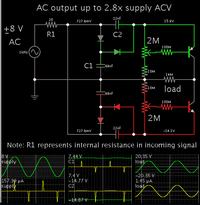luben111
Advanced Member level 1

Hi,
I have to build a sine wave generator on 1 KHz and output voltage 20V p-p. The power supply is ~20-24V (step up from 3V battery) . The load is negligible - less than 1uA. The design should be cost efficient and to consume less than 60uA.
Distortions of the sine wave up to 5-10% are accepted but they have not to contain high frequency spikes or glitches (the curve should look "smooth").
If it's possible to control the step up regulator to directly generate the sine wave it will be even better.
Any ideas and comments will be appreciated.
Thank you.
Best regards,
Luben
I have to build a sine wave generator on 1 KHz and output voltage 20V p-p. The power supply is ~20-24V (step up from 3V battery) . The load is negligible - less than 1uA. The design should be cost efficient and to consume less than 60uA.
Distortions of the sine wave up to 5-10% are accepted but they have not to contain high frequency spikes or glitches (the curve should look "smooth").
If it's possible to control the step up regulator to directly generate the sine wave it will be even better.
Any ideas and comments will be appreciated.
Thank you.
Best regards,
Luben


